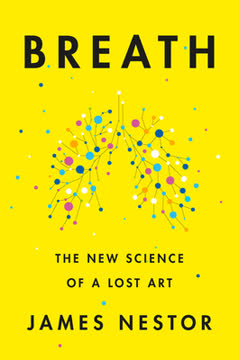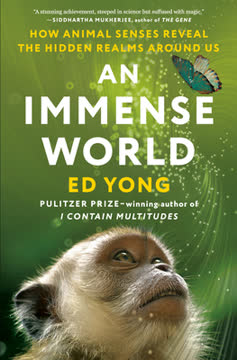Key Takeaways
1. The human body: A marvel of complexity and efficiency
We are both floppy and rigid.
Intricate design. The human body is an astounding feat of engineering, composed of trillions of cells working in harmony. From the microscopic level of DNA to the macroscopic level of organs and systems, every part plays a crucial role in maintaining life.
Remarkable statistics:
- 37.2 trillion cells operating in concert
- 86 billion neurons in the brain
- 60,000 miles of blood vessels
- 7 octillion atoms making up a human
Efficiency and adaptability. Despite its complexity, the body is remarkably efficient. It can heal itself, adapt to various environments, and perform countless functions simultaneously without conscious effort. From the heart pumping blood tirelessly to the immune system battling invaders, the body's systems work in perfect synchronization to keep us alive and thriving.
2. The brain: Our most extraordinary and mysterious organ
You are truly a wonder. But then so, it must be said, is an earthworm.
Unparalleled complexity. The human brain, weighing just 3 pounds, is the most complex object known in the universe. It contains more synaptic connections than there are stars in the Milky Way galaxy.
Key brain functions:
- Processing sensory information
- Controlling voluntary movements
- Regulating involuntary bodily functions
- Storing and retrieving memories
- Generating emotions and thoughts
- Enabling consciousness and self-awareness
Ongoing mysteries. Despite centuries of study, much about the brain remains unknown. Scientists are still working to understand consciousness, memory formation, and the intricacies of neural networks. The brain's plasticity – its ability to rewire itself – continues to astound researchers and offers hope for treating various neurological conditions.
3. The immune system: Our intricate defense mechanism
Make no mistake. This is a planet of microbes. We are here at their pleasure. They don't need us at all. We'd be dead in a day without them.
Constant vigilance. The immune system is a complex network of cells, tissues, and organs that work together to defend the body against harmful invaders. It must distinguish between self and non-self, recognizing and eliminating threats while avoiding damage to healthy tissues.
Key components:
- White blood cells (leukocytes)
- Lymphatic system
- Bone marrow
- Thymus
- Spleen
Balancing act. The immune system must strike a delicate balance between underactivity (leaving us vulnerable to infections) and overactivity (leading to autoimmune disorders). Recent research has revealed the crucial role of the microbiome – the trillions of beneficial microorganisms living in and on our bodies – in supporting immune function and overall health.
4. The digestive system: A sophisticated processing plant
Your brownie is sheet music. It is your brain that makes it a symphony.
Complex journey. The digestive system is a remarkably efficient processing plant, breaking down food into nutrients that can be absorbed and used by the body. This journey begins in the mouth and ends at the anus, involving numerous organs and enzymes along the way.
Key digestive organs:
- Mouth
- Esophagus
- Stomach
- Small intestine
- Large intestine
- Liver
- Pancreas
- Gallbladder
Multifaceted process. Digestion is not merely mechanical breakdown; it involves complex chemical processes and the interaction of various hormones and enzymes. The gut-brain axis, a bidirectional communication system between the digestive tract and the brain, plays a crucial role in overall health and well-being, influencing everything from mood to immune function.
5. The heart and circulatory system: The body's tireless engine
It has been calculated that during the course of a lifetime the heart does an amount of work sufficient to lift a one-ton object 150 miles into the air.
Ceaseless activity. The heart, a muscular organ about the size of a fist, beats approximately 100,000 times a day, pumping blood through about 60,000 miles of blood vessels. This intricate network delivers oxygen and nutrients to every cell in the body while removing waste products.
Components of the circulatory system:
- Heart
- Arteries
- Veins
- Capillaries
- Blood (red cells, white cells, platelets, plasma)
Vital fluid. Blood is not just a transport medium; it's a complex tissue that performs numerous functions, including clotting to prevent blood loss, fighting infections, and regulating body temperature. The composition of blood can provide valuable insights into a person's overall health status.
6. The respiratory system: Our vital link to the outside world
Just look around you now. The eyes send a hundred billion signals to the brain every second.
Constant exchange. The respiratory system facilitates the vital exchange of gases between our bodies and the environment. With each breath, we take in oxygen and expel carbon dioxide, a process essential for cellular metabolism and life itself.
Key respiratory organs:
- Nose and nasal cavities
- Pharynx
- Larynx
- Trachea
- Bronchi
- Lungs
Beyond breathing. The respiratory system does more than just enable breathing. It helps regulate blood pH, facilitates speech production, and even plays a role in our sense of smell. The intricate design of the lungs, with millions of tiny air sacs called alveoli, provides an enormous surface area for gas exchange – about the size of a tennis court when fully expanded.
7. Cancer: The body's rebellion against itself
It is suicide without permission.
Cellular mutiny. Cancer occurs when cells in the body begin to grow and divide uncontrollably, often forming tumors and spreading to other parts of the body. It's not a single disease but a group of diseases with common characteristics.
Hallmarks of cancer:
- Sustained proliferative signaling
- Evasion of growth suppressors
- Resistance to cell death
- Enabling of replicative immortality
- Induction of angiogenesis
- Activation of invasion and metastasis
Complex challenge. Cancer treatment is challenging because cancer cells are essentially our own cells gone rogue. They can evolve to evade detection and resist treatment, making cancer a formidable foe. However, advances in understanding cancer biology, immunotherapy, and targeted therapies are offering new hope in the fight against this disease.
8. Infectious diseases: Ancient foes in a modern world
If you want to imagine what a disease might do if it became bad in every possible way, you could do no better than consider the case of smallpox.
Persistent threats. Despite remarkable advances in medicine, infectious diseases remain a significant global health challenge. From ancient scourges like tuberculosis to emerging threats like COVID-19, pathogens continue to evolve and adapt, posing ongoing risks to human health.
Types of infectious agents:
- Bacteria
- Viruses
- Fungi
- Parasites
- Prions
Global interconnectedness. In our increasingly connected world, diseases can spread rapidly across continents. This interconnectedness poses new challenges for disease control but also facilitates global cooperation in research and response efforts. Vaccination, improved sanitation, and antibiotics have dramatically reduced the impact of many infectious diseases, but antibiotic resistance and the emergence of new pathogens remain significant concerns.
9. The skeleton and muscles: Our framework for movement and strength
Bone is stronger than reinforced concrete, yet light enough to allow us to sprint.
Engineering marvel. The human skeletal system, comprising 206 bones, provides structure, protection for vital organs, and a framework for movement. Bones are not inert structures but living tissues that constantly remodel themselves in response to stress and nutritional factors.
Musculoskeletal system components:
- Bones
- Joints
- Ligaments
- Tendons
- Muscles
Synergistic action. Muscles, working in concert with the skeletal system, enable a wide range of movements, from the precise control needed for writing to the power required for lifting heavy objects. The interplay between bones, joints, and muscles allows for both stability and flexibility, a balance crucial for human locomotion and dexterity.
10. Sleep: The essential reset for body and mind
If sleep does not serve an absolutely vital function, then it is the biggest mistake the evolutionary process has ever made.
Mysterious necessity. Despite spending about a third of our lives asleep, the exact purpose of sleep remains elusive. However, its importance is undeniable, affecting everything from cognitive function to physical health and emotional well-being.
Stages of sleep:
- Non-REM Stage 1 (light sleep)
- Non-REM Stage 2 (deeper sleep)
- Non-REM Stage 3 (deep sleep)
- REM (rapid eye movement) sleep
Multifaceted benefits. Sleep plays a crucial role in memory consolidation, learning, emotional regulation, and physical restoration. It's also essential for maintaining a healthy immune system and regulating metabolism. Chronic sleep deprivation has been linked to a range of health issues, including cardiovascular disease, obesity, and mental health disorders.
11. Reproduction: The miracle of creating new life
Suicide by lifestyle takes ages.
Complex process. Human reproduction is a remarkable feat of biological engineering, involving the precise coordination of numerous systems and processes. From the production of gametes to the development of a fetus and the miraculous event of birth, every step is a testament to the intricacy of human biology.
Key stages of reproduction:
- Gametogenesis (production of sperm and eggs)
- Fertilization
- Embryonic development
- Fetal growth
- Birth
Beyond biology. While reproduction is fundamentally a biological process, it's deeply intertwined with social, cultural, and psychological factors. Advances in reproductive technologies have expanded possibilities for parenthood, while also raising new ethical questions. The study of epigenetics has revealed how environmental factors during pregnancy and early life can influence gene expression and long-term health outcomes, underscoring the importance of prenatal and early childhood care.
Human Anatomy Adaptation
diff --git a/summaries/The Body by Bill Bryson.md b/summaries/The Body by Bill Bryson.md
index 8d62a83..78bf050 100644
--- a/summaries/The Body by Bill Bryson.md
+++ b/summaries/The Body by Bill Bryson.md
@@ -222 @@
Beyond biology. While reproduction is fundamentally a biological process, it's deeply intertwined with social, cultural, and psychological factors. Advances in reproductive technologies have expanded possibilities for parenthood, while also raising new ethical questions. The study of epigenetics has revealed how environmental factors during pregnancy and early life can influence gene expression and long-term health outcomes, underscoring the importance of prenatal and early childhood care.
+### 12. The skin: Our protective barrier and sensory interface
+
+> You are enormous. Your alimentary canal is about forty feet long if you are an average-sized man, a bit less if you are a woman.
+
+Multifunctional organ. The skin, our largest organ, serves as a protective barrier against the environment while also playing crucial roles in temperature regulation, sensation, and vitamin D synthesis. It's a complex organ composed of multiple layers, each with specific functions.
+
+Key functions of the skin:
+- Protection against pathogens and physical damage
+- Regulation of body temperature
+- Sensation of touch, pressure, and temperature
+- Synthesis of vitamin D
+- Water resistance
+
+Resilient and regenerative. The skin is constantly renewing itself, with the outermost layer being completely replaced every 2-4 weeks. This regenerative capacity allows for healing of wounds and adaptation to environmental stresses. The skin also hosts a diverse microbiome, which plays a crucial role in maintaining skin health and protecting against harmful pathogens.
+
Last updated:
FAQ
What's The Body: A Guide for Occupants about?
- Exploration of Human Anatomy: Bill Bryson provides a comprehensive overview of the human body, detailing its structure and functions. The book covers various systems, from the skin to the brain, explaining how they work together.
- Humorous and Informative Style: Bryson combines humor with scientific facts, making complex topics accessible and engaging. His narrative style invites readers to appreciate the intricacies of their own bodies.
- Interconnectedness of Systems: The book emphasizes how different bodily systems are interrelated, showcasing the intricate balance that sustains life.
Why should I read The Body: A Guide for Occupants?
- Unique Perspective on Biology: Bryson offers a fresh take on human biology, blending personal anecdotes with scientific insights, making the subject relatable.
- Educational Value: Readers will gain a deeper understanding of how their bodies function, which can lead to better health awareness and informed lifestyle choices.
- Engaging Storytelling: Bryson's humorous and conversational tone makes complex scientific concepts enjoyable to read, keeping readers engaged throughout.
What are the key takeaways of The Body: A Guide for Occupants?
- Complexity of the Human Body: The book illustrates that the human body is a marvel of evolution, composed of intricate systems that work in harmony.
- Importance of Microbes: Bryson discusses the role of microbes in our bodies, highlighting their significance in digestion and overall health.
- Health Awareness: Understanding how the body functions can empower individuals to make informed health decisions and appreciate their health.
What are the best quotes from The Body: A Guide for Occupants and what do they mean?
- "You are truly a wonder.": This quote encapsulates Bryson's admiration for the human body and its capabilities, serving as a reminder of our extraordinary nature.
- "The miracle of human life is not that we are endowed with some frailties but that we aren’t swamped with them.": Bryson highlights the resilience of the human body despite its imperfections.
- "The only thing special about the elements that make you is that they make you.": This quote reflects on the fundamental nature of human existence, emphasizing our uniqueness.
How does Bill Bryson explain the brain in The Body: A Guide for Occupants?
- Complexity and Functionality: Bryson describes the brain as "the most extraordinary thing in the universe," highlighting its complexity and vast information processing capabilities.
- Energy Consumption: The brain, while only 2% of body weight, consumes about 20% of our energy, showcasing its efficiency.
- Mysteries of Consciousness: Despite extensive research, many aspects of the brain remain mysterious, particularly consciousness and memory.
What insights does The Body: A Guide for Occupants provide about the immune system?
- Defense Mechanism: Bryson describes the immune system as a complex network that protects the body from pathogens, emphasizing its importance in maintaining health.
- Role of White Blood Cells: White blood cells are crucial for immune responses, identifying and attacking invaders, highlighting their significance in our overall health.
- Balance and Functionality: The immune system maintains a delicate balance, ensuring it responds appropriately without overreacting.
How does Bill Bryson address the topic of sleep in The Body: A Guide for Occupants?
- Essential Function: Bryson highlights sleep as a vital process for overall health and well-being, essential for processes like memory consolidation and hormonal balance.
- Sleep Cycles: The book explains the different stages of sleep, including REM and non-REM sleep, and their significance in restorative functions.
- Sleep Disorders: Bryson addresses common sleep disorders, such as insomnia and sleep apnea, and their effects on health.
What does The Body: A Guide for Occupants reveal about the digestive system?
- Complex Process: Bryson describes the digestive system as a complex network that breaks down food and absorbs nutrients, showcasing the intricacies of digestion.
- Role of Microbes: The importance of gut microbes in digestion and overall health is highlighted, noting their role in breaking down food and producing essential vitamins.
- Connection to Health: The book discusses the link between digestion and various health issues, including obesity and diabetes.
How does Bill Bryson explain the significance of skin in The Body: A Guide for Occupants?
- Largest Organ: Bryson emphasizes that skin is the largest organ of the body, serving multiple functions, including protection and sensory roles.
- Self-Repairing Ability: The skin's remarkable ability to repair itself after injury is discussed, reflecting on its aesthetic and functional importance.
- Microbial Ecosystem: Bryson explores the diverse microbial ecosystem present on the skin, illustrating the complexity of our skin's microbiome.
What does The Body: A Guide for Occupants say about the role of diet in health?
- Impact of Nutrition: Bryson emphasizes the importance of a balanced diet for maintaining health and preventing diseases, highlighting the body's resilience despite poor dietary choices.
- Cultural Eating Habits: The book explores how cultural habits influence diet and health outcomes, reflecting on changing dietary practices.
- Connection to Disease: Bryson discusses the link between diet and various health issues, including diabetes and heart disease.
How does Bill Bryson address the concept of aging in The Body: A Guide for Occupants?
- Biological Aging: Bryson explores the biological processes that contribute to aging, including cellular damage and hormonal changes.
- Health Implications: The importance of maintaining health as we age is emphasized, noting that lifestyle choices can significantly influence the aging process.
- Research on Aging: Bryson highlights ongoing research into the biology of aging and potential interventions to improve health in later life.
What are some common misconceptions about the body discussed in The Body: A Guide for Occupants?
- Misunderstanding of Body Functions: Bryson addresses myths about how the body works, such as the belief that we only use 10% of our brains.
- Dietary Myths: The book debunks common dietary misconceptions, explaining the differences between types of fats and their roles in health.
- Health and Longevity: Bryson challenges the notion that certain lifestyle choices guarantee health or longevity, emphasizing the role of genetics and other factors.
Review Summary
The Body: A Guide for Occupants is praised for its engaging and informative exploration of human anatomy. Bryson's trademark wit and accessible writing style make complex topics understandable and fascinating. Readers appreciate the blend of scientific facts, historical anecdotes, and medical discoveries. The book covers various body systems, diseases, and health issues, offering insights into both the known and unknown aspects of human physiology. While some readers found certain sections repetitive or unsettling, most recommend it as an enlightening and entertaining read.
Similar Books










Download PDF
Download EPUB
.epub digital book format is ideal for reading ebooks on phones, tablets, and e-readers.













